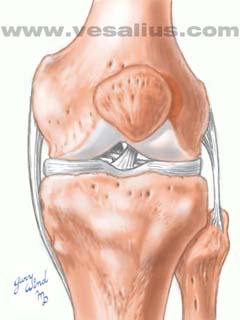BIOMECHANICS OF THE KNEE
Axes of motion
JOINT | AXIS | MOTION | |
|---|
tibio-femoral |
lateral
longitudinal |
flexion/extension
tibial rotation |
extension |
patello-femoral |
ANATOMY
|
|---|
Hochman, M., & Rundle, D. (1995). University of Pennsylvania Medical Center Radiology Interactive. Retrieved 9- 8-99 from the World Wide Web: http://www.rad.upenn.edu/rundle/
Knee/kneeMRICONT.html
the knee in American literature
|  |
|---|
- medial collateral ligament (MCL)
- lateral collateral ligament (LCL)
- anterior cruciate ligament (ACL)
- posterior cruciate ligament (PCL)

|
MCL
LCL
PCL
ACL |
RESIST/LIMIT EXTENSION |
MCL |
RESISTS VALGUS STRESS/FORCE |
|---|
LCL |
RESISTS VARUS STRESS/FORCE |
|
|---|
TIBIO-FEMORAL ARTHROKINEMATICS
Viewed in the sagittal plane, the femur's articulating surface is convex while the tibia's in concave. We can predict arthrokinematics based on the rules of concavity and convexity:
| DURING KNEE EXTENSION | DURING KNEE FLEXION | |
|---|
|
|
OPEN CHAINCLOSED CHAIN |
|
|---|
TIBIA GLIDES ANTERIORLY ON FEMUR |
FEMUR GLIDES POSTERIORLY ON TIBIA |
TIBIA GLIDES POSTERIORLY ON FEMUR |
FEMUR GLIDES ANTERIORLY ON TIBIA |
|---|
| from 20o knee flexion to full extension |
from full knee extension to 20o flexion |
|---|
|
Femur rotates internally on stable tibia |
|
Femur rotates externally on stable tibia |
|---|
THE "SCREW-HOME" MECHANISM
Rotation between the tibia and femur occurs automatically between full extension (0o) and 20o of knee flexion. These figures illustrate the top of the right tibial plateau as we look down on it during knee motion.
 |
 |
 |
| DURING KNEE EXTENSION, the tibia glides anteriorly on the femur. |
During the last 20 degrees of knee extension, anterior tibial glide persists on the tibia's medial condyle because its articular surface is longer in that dimension than the lateral condyle's. |
Prolonged anterior glide on the medial side produces external tibial rotation, the "screw-home" mechanism. |
THE SCREW-HOME MECHANISM REVERSES DURING KNEE FLEXION
 |
 |
 |
| When the knee begins to flex from a position of full extension, posterior tibial glide begins first on the longer medial condyle. |
Between 0 deg. extension and 20 deg. of flexion, posterior glide on the medial side produces relative tibial internal rotation, a reversal of the screw-home mechanism. |






